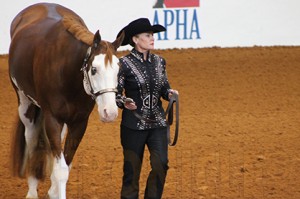Quick and Easy APHA World Show Check In Tips Including Identification, Paddock Check In, and Equipment Inspection
PHJ press release by: Jessica Hein
Is this your first time to attend the APHA World Championship Show? Want to make your show check-in process a breeze? Get the 411 on making your check-in process quick, convenient and easy as pie.
1. Get your stall assignments, show packet and exhibitor numbers.
Your first stop will be the Stall Office, located in the Moncrief Building. Pick up your barn assignments and stall number, and order shavings at the Will Rogers Memorial Center office, located immediately next door to the Stall Office.
After you get your Paint settled, head over to the Show Office—located in the Brown-Lupton Exhibit Hall, part of the Richardson Bass Building—to pick up your exhibitor number and packet, which is full of important information. Don’t just toss your exhibitor packet in the corner—take a few minutes to check out its contents for valuable information.
2. Get your Paint positively identified.
Grab a copy of your horse’s registration papers and head to the identification station, located near the check-in paddocks for most show arenas. Every horse competing at the World Show must be positively identified by a designated inspector—this person makes sure the horse’s markings match those on the registration papers, and he or she also makes sure any relevant brands, scars or distinguishing features like blue eyes are noted on the horse’s papers.
ID stations are open one hour before classes begin each day, and they close at 5 p.m. daily—make sure your horse is positively identified well ahead of your class, as you’ll need a stamp on the exhibitor numbers to be eligible to show. You can also get your numbers laminated at the ID station after they are stamped.
3. Before your class, check in at the paddock.
As your class draws near, listen for announcements calling entries in your class to the paddock. You’ll need to check in with the paddock steward.
4. Be ready for an equipment inspection.
At the paddock, before you head down to the holding pen, the equipment judge will give you and your horse the once over to make sure you’re legal to compete. This include making sure you have the proper tack and attire, correct numbers that are displayed appropriately, and legal tail-extension attachments. For safety reasons, you’ll have to dismount for the equipment check, which usually includes dropping the bridle, too. Read the Official APHA Rule Book in advance to make sure your tack and attire is legal, and that you understand APHA’s logo policy. If you have any questions, feel free to ask the stewards to check your tack or attire for legality well in advance of your class.
Exhibitors in some events will also be checked by an equipment judge after their run, just to make sure no inhumane treatment occurred during the class.
Want more tips?
Check out the full article, Off & Running, online at oawcs.apha.com.
One of the best ways to arm yourself for the World Show experience is to be familiar with the Official APHA Rule Book, especially the rules that pertain to your class. The Rule Book is a wealth of information, including how a class is judged, class procedures and expectations, penalties, legal equipment and more.
Whether you’re new to the World Show or a veteran, APHA is always available to help—feel free to ask a staff member or visit the MemberCare Booth or Horse Show Office. Good luck!











